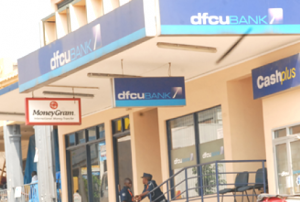dfcu Bank half-year results beyond expectations

Acquisition of some Crane Bank assets helped to swell dfcu Bank such that it could report a half year net profit of $31 million.
August 16—Dfcu Bank, who earlier this year snapped up the some assets of Crane Bank, (formerly Uganda’s fourth largest bank), made a profit in the first half of 2017 that is four times more than that recorded at the end of June 2016.
Net profit rose to UGX 114 billion (about $31 million) compared to UGX 23.3 billion ($6.3 million) recorded after the first six months of 2016 and probably is the highest seen in the industry during H1 2017.
William Sekabembe, the dfcu Bank Executive Director said they are positioned to become the biggest bank in Uganda. “We want to become market leaders. And part of our strategy is to transform dfcu from a niche bank focusing on SMEs to a fully universal bank that provides all services across the spectrum.”
The dfcu Bank half year performance for 2017 is even better than the whole of 2016. According to the figures, for FY 2016, dfcu Bank made UGX 45.3 billion (region of $12.5 million) and UGX 58.3 billion ($16 million) in net and gross profit respectively.
Deposits grew from UGX 982 billion to UGX1.8 trillion while its assets tripled to a sum of UGX 3 trillion (nearly $850 million), year-on- year. “The bank’s total capital as at December 2016 stood at about UGX 262 billion. With the acquisition of Crane Bank, it has almost doubled. That demonstrates the value which dfcu Bank has today and the potential that it has to deliver value to our shareholders,” Kate Kizza, the DFCU Head of Finance said during a news conference.
dfcu Limited was incorporated under the Laws of Uganda on May 14th, 1964, as a Private Limited Liability Company. In 1999, dfcu acquired Uganda Leasing Company which became dfcu Leasing, to provide direct asset based finance. Leasing is an alternative means of financing plant, equipment, machinery, commercial vehicles and business cars.
In May 2000, dfcu acquired Gold Trust Bank which became dfcu Bank, thus extending the services of the Bank to encompass general banking services in addition to the already existing equity finance, long term development finance, leasing, and working capital finance.
The acquisition of Crane Bank assets helped beef up the dfcu Bank results. Worries about lack of adequate capitalisation at Crane Bank and a bursting non-performing loan book convinced Bank of Uganda (BoU) to step in towards the end of 2016
BoU placed Crane under receivership until dfcu proved it had the financial muscle and capability to takeover. Total customer deposits inherited by dfcu Bank from Crane Bank were worth UGX 600 billion. dfcu Bank’s loan book has also grown to UGX 1.3 trillion from UGX 759 billion in the first half of 2017 compared to the same period in 2016.
Sekabembe said a bigger balance sheet has now placed dfcu Bank in a position to expand its lending capacity in new sectors. “We are looking to invest in technology and our digital strategy focuses on mobile and agency banking. As big players, we plan on rolling out over 1,000 agents in the next six months. We shall keep our branches, but at optimum level,” Sekabembe said.

 African Heads of state head to South Korea next week for Summit talks
African Heads of state head to South Korea next week for Summit talks
 Trading leads as main source of income for Ugandans
Trading leads as main source of income for Ugandans
 New leadership for bankers’ umbrella as total assets top $12 billion
New leadership for bankers’ umbrella as total assets top $12 billion
 Brussels Airlines to announce Nairobi service
Brussels Airlines to announce Nairobi service
 SITA promises enhanced travel experience after Materna acquisition
SITA promises enhanced travel experience after Materna acquisition
 Saudia’s 105 aircraft order stretches A320neo lead over rival Max
Saudia’s 105 aircraft order stretches A320neo lead over rival Max
